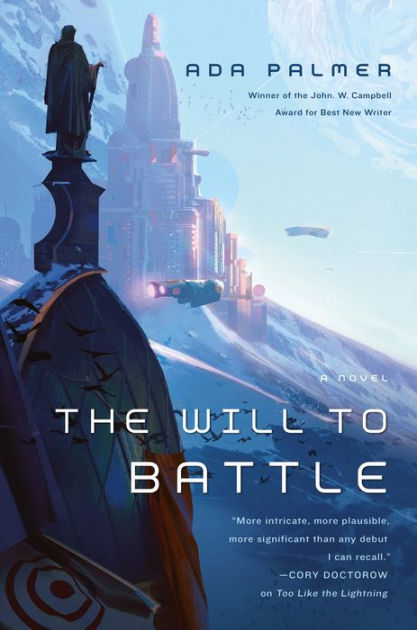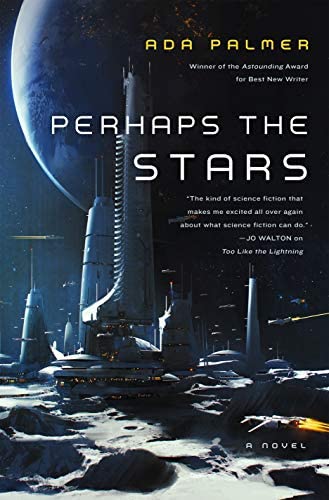As a transport planner with a strong interest in science fiction, I am obviously provoked by this tweet:
I’m going to keep saying this: a sizeable share of contemporary science fiction is really just bad faith rationales for not building bus lanes. https://t.co/oq9aeHtTMq
— Scott Edgar (@scottedgar) March 17, 2019
Scott is talking about flying cars, a staple of science fiction at least since The Jetsons. And as it happens, one of the most fascinating science fiction series of recent years — at least for anyone interested in politics, history, philosophy, or public policy — is about a 25th Century world where automated flying Uber has crushed all other modes of transport, creating a dreaded concentration of monopoly power from which flow the crises that drive the plot.
 Historian Ada Palmer’s four “Terra Ignota” books, which begin with Too Like the Lightning and will end later this summer with the Perhaps the Stars, tell of a world where globe-spanning flying cars have done away with geographic nations, where “it does not take a firebrand leader to make someone who lives in Maui, works in Myanmar, and lunches in Syracuse to realize the absurdity of owing allegiance to the patch of dirt where babe first parted from placenta.” [p43] Indeed, at 9,640 km/h, you’ll only need an hour to get from your job in Myanmar to lunch in Syracuse, Italy — and a half-hour longer to get to Syracuse, New York. (The people of this world seem to have no concept of sonic booms, presumably for the same reason that fish don’t have a concept of water.)
Historian Ada Palmer’s four “Terra Ignota” books, which begin with Too Like the Lightning and will end later this summer with the Perhaps the Stars, tell of a world where globe-spanning flying cars have done away with geographic nations, where “it does not take a firebrand leader to make someone who lives in Maui, works in Myanmar, and lunches in Syracuse to realize the absurdity of owing allegiance to the patch of dirt where babe first parted from placenta.” [p43] Indeed, at 9,640 km/h, you’ll only need an hour to get from your job in Myanmar to lunch in Syracuse, Italy — and a half-hour longer to get to Syracuse, New York. (The people of this world seem to have no concept of sonic booms, presumably for the same reason that fish don’t have a concept of water.)
In place of nations 25th Century earth has organized itself into Hives, non-geographic entities that do much of what nations do. They have governments, laws, shared values, capitals, and cultures, but they don’t control patches of land. You can choose which one to belong to, and still live anywhere.
For my readers who work in city planning or transport, many skeptical questions now jump to mind, so first let me say this: These books are superb. They are funny. They’re erudite but not intimidating, cheerfully explaining the key points of philosophical history when you need to know them. They are driven by brightly sketched and often endearing characters. They bristle with sharp ideas about everything from the enduring appeal of monarchy to the minefield of gendered pronouns. They are especially interested in how societies use and distort the past; this, for example, is a world run by leaders who love an idealized memory of the European 18th Century — the philosophy, the politics, the hoopskirts and wigs — much as the Renaissance (Palmer’s expertise) was built on an idealized memory of ancient Greece and Rome.
This, in short, is what happens when historians write science fiction. We have lots of science fiction where the science is meticulous but the history and culture are thin. These books are the opposite. Here, the technology is lightly and questionably sketched, but the cultural, political, and social consequences of that technology are worked out with stunning detail and plausibility. Even if I doubt its technological premise, this alternative world — one that hasn’t had a war for centuries — was one that I could believe in while I was inside of it.
Still, all of it is built on universal, cheap, and frictionless flying cars. There seems to be no reason not to go anywhere in the world, at any time.

After wondering how anything this energy-intensive could be provided in such abundance that people never discuss its cost, the economist asks: Why would there still be cities? They do exist, and some of them seem to have streets that people walk along, so perhaps people still like being around other people. Progressive urbanists will breathe a sigh of relief when they encounter these scenes.
But most of the cities we visit are capitals of Hives or of other Hive-like communities, and if we’re not there to see powerful people in secret chambers, then we are often there almost as tourists, seeing the sights and savoring the uniqueness and symbolism of the city. Maybe the few pedestrian-filled streets that we see are like those of Colonial Williamsburg or Disneyland. We don’t delve into how the cities function beyond their role as stage sets for the drama. It’s not clear that they function as cities at all.
The city we meet first, Cielo de Pájaros in Chile, is designed to attract vast clouds of birds but lacks commercial districts. It’s a “city designed for for those who don’t like city centers, whose perfect evening is spent by a window, watching gulls and black waves crashing down.” [p31] Clearly if there’s universal Uber there must also be universal Amazon, delivering fish fresh off the dock from your choice of Portugal or Maine, so maybe nobody needs shops anymore. But again, if you don’t like the bustle of human activity, why live in a city? Why not scatter in cabins all along Chile’s coast?
If members of different Hives live side by side while obeying different sets of laws, what law is in force when they interact? For Palmer this is a simple problem of inter-Hive crime, so she images a system of “polylaw” that brings a neutral justice to bear. But a city that functions (rather than just symbolizes) needs a much finer shared web of legal and cultural systems. There must still be rules about where you can land a flying car, or what you can throw in a sewer drain that goes to the local river, or whether you can build a factory next to people’s homes.
In the absence of such rules, we must imagine the libertarian urban world that the unrestrained flying car would make. In the first chapter, even before you meet a child who performs decidedly religious miracles, you will encounter Palmer’s most unbelievable sentence:
Carlyle bade the car touch down, not on the high drawbridgelike walkaway which led to the main door of the shimmering [house], but by the narrow maintenance stairs beside it. [p14]
You can fly across the world on a car that will land on your preferred side of a house, so that you don’t have to walk even a few steps. Later, we even see this done in Paris. Even today you shouldn’t expect Uber to come to your exact address in a dense city, and there will be lots of honking if it does. Bus lanes, bike lanes, pedestrians, deliveries — all these things need space in the street. If a flying car can land in Paris exactly where the customer wants, what does the narrow Parisian street look like? Is there room to walk? What’s left for anything but landing space? 
But while city planners may puzzle over these things, Palmer’s books still ask great questions that are at the heart of the question of cities: Are you sure we should want to “abolish geography”, as so many transport gadget inventors have promised over the years? Would you really want to “live in Maui, work in Myanmar, and lunch in Syracuse,” or would you feel that in a world of such universal travel, all these places have become so identical that you might as well work from home? If you did that, would you even go for a walk in your neighborhood, meeting familiar people in the flesh, when you could just as easily walk in a city that’s having better weather at the moment? Will you like a placeless society where you and your neighbor listen to different news sources to the point that you have incompatible views about reality? If so, would you still be able to cooperate about fixing the fence or agreeing on quiet hours? And if that incomprehension got out of hand, then whoa, what would a war between Hives be like?
Whatever your first reaction to those questions, Palmer’s books will add nuance to it. If you enjoy thinking about politics, philosophy, history or public policy (and if you are willing to live without the presumptive atheism of most science fiction) I think you’ll enjoy these books. And I promise: Your skepticism about flying cars will survive the journey.
I love these books so much, but the description she gives of Cielo de Pajaros was definitely the thing I was most skeptical of, and most curious about. I really liked this description by John Holbo at Crooked Timber:
“She puts the ‘sf’ in sfumato when it comes to rendering detail. You think you see it, but when you try to focus on the periphery, your eye chases it away, like smoke. (It’s a device of realism, like Mona Lisa’s elusive smile.)
Infodump as impasto, to shift painting metaphors. Palmer lays it on thick while keeping it broad-brush. So many foreground elements fail to resolve for so long. If they ever do. Am I missing something? Weird things—weird people, events, connections—partially explained, yes … albeit sometimes only 400 pages later. Are they ever fully explained?”
https://crookedtimber.org/2017/03/17/heroes-and-aliens/
This is a great technique for exploring a lot of fascinating social consequences of a future that is a more realistic cross between utopia and dystopia than anything I’ve seen. It just misses some of the consequences of transport technology, in favor of analyzing others.
That said, her understanding of space and history in a city is really foregrounded in her blog posts about Rome: https://www.exurbe.com/the-shape-of-rome/
Kenny. Thanks for those links. I think Holbo has it right, and still, for a science fiction novel to be vulnerable to such a refined critique, it must be pretty great.